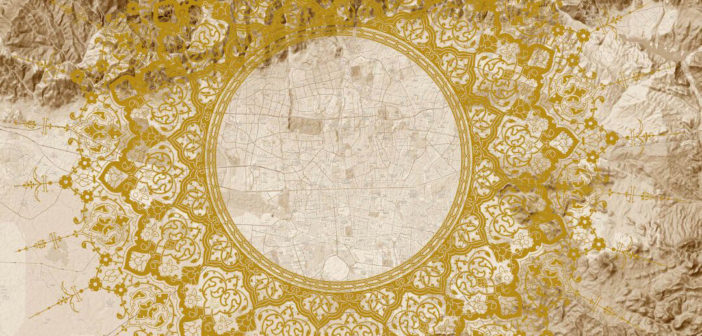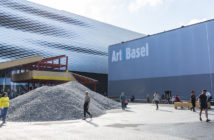Crossing Borders is a reflection of intercultural identity, both for the artists represented and for the larger society in which we operate. At times it feels like a celebration, sometimes like a confrontation, while yet other moments take a more nuanced approach. From Heeseop Yoon to Saman Sajasi to Julia Mandle, the artists presented here call out to their viewers in a cacophony of languages, both written, visual and metaphoric.
Ten artists (local and international) of diverse cultural and national identities, overflow Periphery Space's small but airy gallery on the first floor of an old Pawtucket mill. Curators Judith Tolnick Champa’s and Jocelyn Foye’s interests in the exhibition are as equally ambitious and globe trotting as the artists they tapped for the exhibition. Champa writes in the accompanying essay that “Crossing Borders is not art about isolation, distance, loss or longing, but about making space for creativity across borders-- despite and in the face of a troubled and troubling contemporary world.” Together Champa and Foye have sought out these artist to help them tackle the many and often overwhelming issues we face as a society from gender inequality, xenophobia, immigration, the global refugee crisis and the on going discussion of what the metaphor “the melting pot” means or should mean. All of these ideas and even the works shown here are brought into new and stark focus by the current political climate within the United States, whether or not the work was intended to be viewed by an American audience.
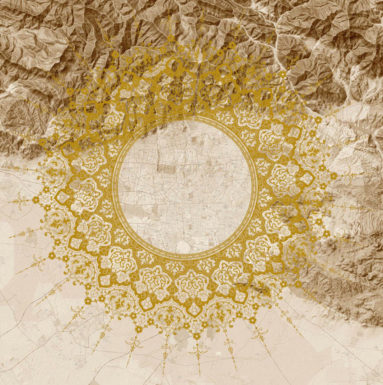
Saman Sajasi, "Glory", 2013. Courtesy of the artist.
This is no easy task, taking on these issues with strength and grace in equal parts, nor is it easy to focus in on one or another as needing our attention first. In wandering the gallery is apparent that Champa and Foye took on the curatorial task they set themselves with both courage, enthusiasm and thoughtfulness in equal parts. There are moments when the exhibition’s many components come together in couplets of harmony with a quiet and resonant hum, like the works of Roya Amigh and Saman Sajais. Amigh’s “Silent Diary”, a table top scattered with tool and materials as though a manic crafter has just left the room, pairs itself well with the equally chaotic maps on top of which Sajasi overlays her meditative and orderly mandalas. Together they act as a before-and-after, the act of creating a system, of organizing thoughts and emotions, and the order created, all of it in golds and silvers.
Another coupling that comes to mind are Teruko Isabella Kushi’s “The Back of my head” and Esperanza Mayobre’s “Welcome to de Yunaited Estai.”Each piece points directly at those attributes which some might pointed to as being signifiers of otherness: language and physical appearance. These two pieces are bold statements that ask us to look directly at these signifiers and to analyze them. They bring up the idea of “the melting pot” and whether it is a idea of assimilation or one that calls on us to celebrate those individual identities that come together to form a larger identity as a culture.
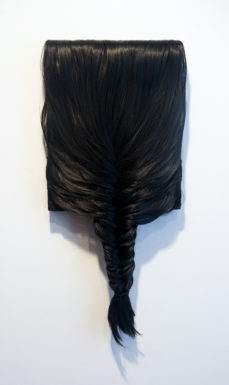
Teruko Isabella Kushi, "The Back of my head." Courtesy of the artist.
At times it feels as if Foye and Champa were perhaps a bit too ambitious in their selection, some pieces feel like they have been squeezed into the space like Poonam Jain’s “Accessories” which, although her intent is to represent a door, it’s placement in the gallery (incorporated with the rooms architecture) verges on too door-like to the point that I overlooked this subtle readymade assemblage of hardware on my first rotation through the space. Similarly, Camilo Cruz’s “Metal Detector” feels out of place in the larger context in the exhibition, again, mostly due to it’s placement and the restrictions of an ambitious show in a relatively small square footage. “Metal Detector”, also a ready made, is paced so that it must be walked through to enter the space. Cruz, whose work is interested in the ability of bureaucracy to dehumanize, sets a tone by way of this entrance. The entrance is one we are familiar with in courthouses and other government institutions and is confrontational and authoritarian. I feel this is not the overall tone of the artworks once inside the gallery, works that view race, gender, cultural identity and citizenship with a much more inclusive, subtle and inquisitive approach. Even Cruz’s other work in the show, “Adeliz” a large photograph of a mother and her two children, one of whom is turned toward us with a doe eyed gaze, feels more inline with the rest of the exhibition.
These details aside, Crossing Borders is a level-headed artistic approach to the narrow minded rhetoric with which Western culture is grappling with. The curators and the artists are taking on these issues with a keen and empathetic eye. They are empowered by personal experiences which they are expand to a global audience. The exhibition varies from artists to artist in subject matter, materials and aesthetics but they all come together to address our overarching need for open minded and open hearted discussion of the critical issues that have formed our personal and societal identities both directly and indirectly.
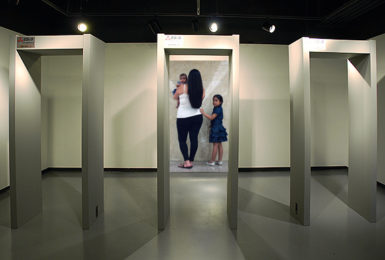
Camilo Cruz, "Metal Detector" and "Adeliz," 2017. Courtesy of the artist.
Crossing Borders is on view at Periphery Space until October 14th with a conversation between artists Saman Sajasi and Maya Krinsky on October 5th.

